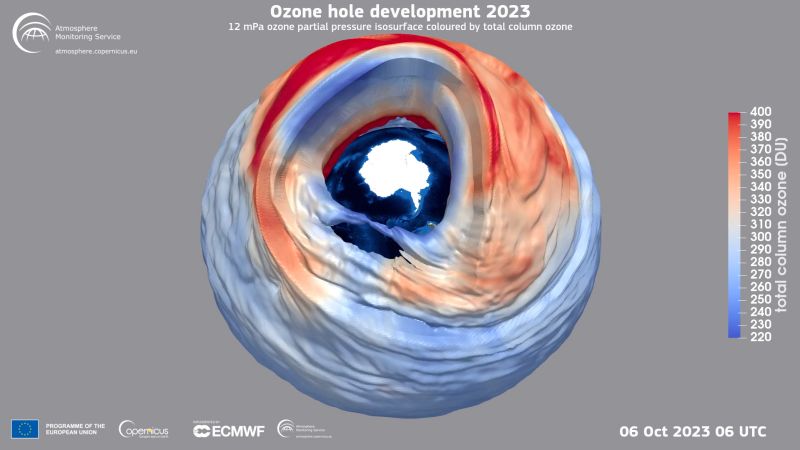
Copernicus Atmosphere Monitoring Service
Simulated image of the ozone hole in October over Antarctica.
CNN
—
the Restoring the ozone layer – which sits miles above Earth and protects the planet from ultraviolet rays – has been celebrated as one of the world’s greatest environmental achievements. But in In a new study published on Tuesday, some scientists claim that it may never recover, and that the hole may expand.
The findings contradict widely accepted assessments of the state of the ozone layer, including a recent UN-backed study that showed it would return to 1980s levels as soon as 2040.
In 1987, several countries agreed to ban or phase down the use of more than 100 ozone-depleting chemicals that had created a “hole” in the Antarctic layer. The depletion is mainly due to the use of chlorofluorocarbons, or CFCs, which were common in aerosol sprays, solvents and refrigerants.
This ban, agreed under the Montreal Protocol, is widely considered effective in helping the ozone layer recover.
But the hole, which grows over Antarctica during the spring before shrinking again in the summer, reached record sizes in 2020 to 2022, prompting scientists in New Zealand to investigate the cause.
In a paper published in the journal Nature Communications, they found that ozone levels have fallen by 26% since 2004 in the core of the Antarctic spring hole.
“This means that the hole not only remained large in area, but also became deeper [i.e. has less ozone] “During most of the Antarctic spring,” said Hannah Kessenich, a doctoral student at the University of Otago and lead author of the study.
“Particularly long-lived ozone holes during 2020-2022 fit directly into this picture, as hole size/depth during October was particularly notable in all three years.”
To reach this conclusion, scientists analyzed the behavior of the ozone layer from September to November using a satellite instrument. They used historical data to compare this behavior and changing ozone levels, and measure signs of ozone recovery. They then sought to determine what was driving these changes.
They found that the ozone depletion and deepening of the hole were the result of changes in the Antarctic polar vortex, a vast vortex of low-pressure, very cold air, high above the Antarctic.
The study’s authors did not go further to explore the reasons for these changes, but they acknowledged that many factors could also contribute to ozone depletion, including pollution that warms the planet; small airborne particles emitted by forest fires and volcanoes; And changes in the solar cycle.
“Overall, our findings reveal that the recent large ozone holes may not be caused solely by CFCs,” Kesinich said. “So, while the Montreal Protocol has been indisputably successful in reducing CFCs over time and preventing environmental catastrophes, persistent Antarctic ozone holes appear closely linked to changes in atmospheric dynamics.”
Some scientists question the results of the study, which relies heavily on holes observed from 2020 to 2022 and uses a short period – 19 years – to reach conclusions about the long-term health of the ozone layer.
“Existing literature has already found reasons for these large ozone holes: smoke from the 2019 wildfires and the volcanic eruption (La Soufriere), as well as the general relationship between the polar stratosphere and the El Niño Southern Oscillation,” said Martin Joker, a scientist at the University of California. The Climate Change Research Center at the University of New South Wales in Australia told the Science Media Centre.
“We know that during La Niña years, the polar vortex in the stratosphere tends to be stronger and colder than normal, which means ozone concentrations will also be lower during those years. The years 2020-22 have seen a rare triple La Niña event, but no This relationship was never mentioned in the study.
He noted that the study authors said they removed two years from the record — 2002 and 2019 — to ensure that “extraordinary events” did not skew their findings.
“Those events have been shown to significantly reduce the size of the ozone hole, so including those events probably would have negated any long-term negative trend,” he said.

“Web maven. Infuriatingly humble beer geek. Bacon fanatic. Typical creator. Music expert.”



:quality(85)/cloudfront-us-east-1.images.arcpublishing.com/infobae/4OGKYRHJX5HQ7GWNLLKJOED5XM.png)
More Stories
Live updates from the Starlink Falcon 9 launch at KSC
The Starliner launch was delayed to mid-May
Boeing Starliner launch delayed until at least May 17 – Orlando Sentinel